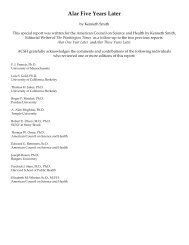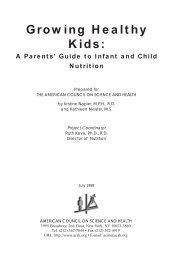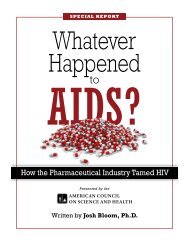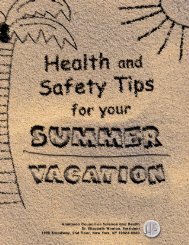Health and Safety Tips for Your Summer Vacation (Update 2010)
Health and Safety Tips for Your Summer Vacation (Update 2010)
Health and Safety Tips for Your Summer Vacation (Update 2010)
Create successful ePaper yourself
Turn your PDF publications into a flip-book with our unique Google optimized e-Paper software.
• Don’t use on cuts, wounds or irritated skin.<br />
• Do not let children h<strong>and</strong>le repellents, <strong>and</strong> don’t<br />
apply to their h<strong>and</strong>s.<br />
• Apply to h<strong>and</strong>s <strong>and</strong> then apply on face—don’t<br />
apply or spray directly on face.<br />
• Don’t spray repellent in enclosed areas or<br />
around food. Avoid breathing sprays.<br />
Insect bites <strong>and</strong> stings can also pose serious<br />
threats to those who become allergic to them. In<br />
the most serious cases, a sting or bite can cause<br />
anaphylaxis, a life-threatening condition that<br />
requires immediate medical attention. Its symptoms<br />
can include localized swelling, dizziness,<br />
shortness of breath, a drop in blood pressure, <strong>and</strong><br />
loss of consciousness. Fortunately, most bites <strong>and</strong><br />
stings result in much less serious <strong>and</strong> more localized<br />
reactions, like pain, itching, <strong>and</strong> swelling.<br />
Warning signs of impending allergic reactions<br />
may include some wheezing <strong>and</strong> swelling of the<br />
tongue.<br />
To avoid any of the above reactions, it’s important<br />
to avoid stings <strong>and</strong> bites whenever possible.<br />
Stinging insects like honeybees, wasps,<br />
<strong>and</strong> hornets are more active during the summer.<br />
Un<strong>for</strong>tunately, repellents don’t work against<br />
them. Be cautious when working or playing in<br />
areas where their nests are likely to be located,<br />
such as near bushes, trees, <strong>and</strong> buildings. Some<br />
additional precautions you can take include:<br />
• Wear shoes—not s<strong>and</strong>als—when walking outside,<br />
<strong>and</strong> don’t go barefoot.<br />
• Never swat at flying insects.<br />
• Keep food covered as much as possible when<br />
outdoors.<br />
• Keep garbage in tightly closed containers.<br />
• Avoid perfumes, hairsprays, <strong>and</strong> sweet-smelling<br />
fragrances when spending time outdoors.<br />
• Avoid brightly colored clothing.<br />
• Drive with the car windows closed.<br />
• If stung by a honeybee, scrape the stinger<br />
out—don’t squeeze it or you’ll squeeze more<br />
venom into the skin.<br />
Lyme Disease<br />
If your idea of a great way to spend a vacation<br />
includes hiking or camping in brushy <strong>and</strong> wooded<br />
areas, or if you live in such an area, be aware<br />
of the possible presence of the tiny deer ticks<br />
that carry Lyme disease. The deer ticks are much<br />
smaller—about the size of a sesame seed—than<br />
the more common dog ticks. Although cases of<br />
Lyme disease have been reported by 48 states<br />
<strong>and</strong> the District of Columbia, most cases are<br />
concentrated in the northeastern, north central,<br />
<strong>and</strong> Pacific coastal areas. About 15,000 cases of<br />
Lyme disease are reported each year.<br />
Lyme disease is the most common tick-transmitted<br />
illness, <strong>and</strong> though there is a wide range of<br />
variability in the severity, order of appearance,<br />
<strong>and</strong> duration of symptoms amongst those with<br />
Lyme disease, the “typical” illness pattern is<br />
manifested in three clinical stages:<br />
• Stage I: Skin rashes <strong>and</strong> flu-like symptoms<br />
• Stage II: Neurological, cardiac, <strong>and</strong> musculoskeletal<br />
symptoms<br />
• Stage III: Arthritic <strong>and</strong> other neurological<br />
symptoms (i.e., sleepiness, inability to concentrate,<br />
loss of memory)<br />
If untreated, about 80% of patients who get Lyme<br />
disease will progress beyond Stage I symptoms of<br />
the disease. While Stage II <strong>and</strong> III symptoms are<br />
more serious, with treatment they generally disappear<br />
within weeks. Authorities at the Centers<br />
<strong>for</strong> Disease Control do not recommend immediate<br />
treatment with antibiotics if an attached tick<br />
is found. Recent research indicates that transmission<br />
of Lyme disease does not occur immediately<br />
when a tick bites. It may take up to 24 hours after<br />
the bite <strong>for</strong> the bacteria to be transmitted. Thus,<br />
if a tick is removed soon after it has attached, it<br />
may not have passed on the bacteria.<br />
Studies have been per<strong>for</strong>med on the utility of<br />
immediate antibiotic treatment <strong>for</strong> tick bites<br />
be<strong>for</strong>e the appearance of disease symptoms. The<br />
researchers found that side effects from early<br />
antibiotic treatment were more common than the<br />
6










